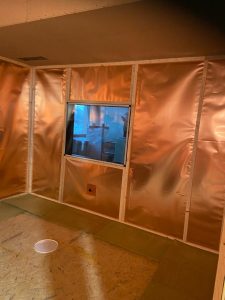RF shielding, an essential aspect of modern technology, serves as a protective barrier against radio frequency interference (RFI). While this concept may seem straightforward, the implications and applications are vast, especially when considering specialized areas like RF shield for MRI equipment.
Understanding RF cage versus EMI Shielding
RF shielding and electromagnetic interference (EMI) shielding are often used interchangeably, but they address distinct frequency ranges. RF shielding primarily targets frequencies within the radio transmission range, whereas EMI shielding encompasses higher frequencies used in various applications beyond radio transmission. However, both are crucial for safeguarding sensitive devices against signal disruption.
Importance of RF Shielding Against RFI
The repercussions of RFI interference span from signal distortion to severe consequences such as compromising biometric data in passports or disrupting critical medical equipment like MRI machines. Without adequate shielding, electronic devices are susceptible to malfunction, highlighting the necessity of comprehensive RF shielding solutions.
Sources and Impact of RFI
RFI originates from both natural phenomena like lightning strikes and man-made sources such as power transmission lines and radar systems. These signals, intentional or not, can disrupt nearby electronic devices, emphasizing the need for robust RF shielding measures.
Mechanisms Behind RF Shielding
Despite the omnipresence of radio waves, effective RF shielding redirects and blocks incoming signals through strategic design and conductive materials. Various shielding techniques, including Faraday cages, gaskets, O-rings, solid enclosures, vent shields, cable shields, board shields, and shielded facilities, offer tailored solutions for different applications.
Types of RF Shields
Faraday cages, named after scientist Michael Faraday, employ conductive wire mesh to enclose devices, preventing external RF signals from penetrating.

Gaskets and O-rings, made with RF-resistant materials filled with conductive particles, seal openings in enclosures to block RFI effectively. Solid enclosures, vent shields, cable shields, board shields, and shielded facilities each serve unique purposes in safeguarding devices against RFI, ranging from circuit boards to entire buildings.
Ensuring Accuracy and Safety: RF Shielding for MRI
Radiofrequency (RF) shielding is a critical requirement for MRI scanners, serving two primary functions. Firstly, it prevents extraneous electromagnetic radiation from distorting the MR signal. Secondly, it safeguards against electromagnetic radiation generated by the MR scanner, which could potentially interfere with nearby medical devices.
The frequencies emitted by different strength MRI scanners often overlap with those utilized by various private and commercial communication devices. While rare, if an MRI scanner is situated near a broadcast TV station or in a home with a ham radio enthusiast, it can lead to interference issues. However, the most common source of RF interference stems from noise generated by nearby electrical equipment or electronic devices.
Manufacturers typically mandate that the magnet room has at least 100dB of RF attenuation at the Larmor frequency to ensure optimal performance. To achieve this level of shielding, specialized construction firms such as ETS-Lindgren or National MRI Shielding are often engaged for design and oversight.
An ideal RF-shielded magnet room comprises three nested components: an outer shell for structural support, a middle metallic RF shield, and an interior layer made of finish materials. The RF shield must completely enclose the room, including walls, floor, and ceiling, resembling a Faraday cage.
Various metals, including aluminum and galvanized steel, can be utilized for the RF enclosure. However, the most common material is wood panels wrapped with copper, thanks to copper’s shallow skin conductive depth at MRI frequencies.
The floor typically consists of monolithic copper covered with a solid antistatic flooring material, while the interior walls are finished with drywall. The ceiling is suspended from the RF shield to accommodate recessed lighting and mechanicals.
Ensuring a tight seal is crucial for the door to prevent RF leakage. Electrical contact strips or a continuous metallic pneumatic tube are often used for sealing, although RF seals around the door can be prone to damage due to repetitive opening and closing.
Windows in the RF-shielded room are laminated with blackened copper mesh between two glass panels, ensuring peripheral connection with the RF enclosure walls to maintain integrity.
Conclusion
RF shielding is indispensable in today’s technology-driven world, protecting devices from the pervasive threat of RFI. Whether safeguarding consumer electronics or critical medical equipment like MRI machines, implementing effective RF shielding solutions is paramount for uninterrupted functionality and data integrity.
Related Post
Medx Solution is a young company with dynamic growth. We are specialist in radiofrequency shielding acting in medical field (MRI systems) and science faculties.